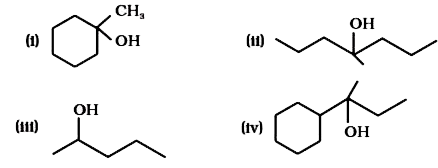Complete Solutions to EXERCISE of chapter ALCOHOLS , PHENOLS AND ETHERS of Class 12 book with complete answers and questions
| Class 12 | CHEMISTRY |
| Chapter | ALCOHOLS , PHENOLS AND ETHERS |
| NCERT TELUGU | EXERCISE |
| Number Of Questions | 32 |
| Academic Year | 2023-24 |
Write structures of the compounds whose IUPAC names are as follows:
(i) 2-Methylbutan-2-ol (ii) 1-Phenylpropan-2-ol
(iii) 3,5-Dimethylhexane –1, 3, 5-triol (iv) 2,3 – Diethylphenol
(v) 1 – Ethoxypropane (vi) 2-Ethoxy-3-methylpentane
(v) 1 – Ethoxypropane (vi) 2-Ethoxy-3-methylpentane
(vii) Cyclohexylmethanol (viii) 3-Cyclohexylpentan-3-ol
(ix) Cyclopent-3-en-1-ol (x) 3-Chloromethylpentan-1-ol.
View SolutionDraw the structure of all isomeric alcohols of molecular formula `C_(5)H_(12)O` and give their IUPAC names and classify them as primary , secondary and tertiary alcohols.
View SolutionExplain why propanol has higher boiling point than that of the hydrocarbon-butane.
View SolutionWhich of the following is soluble in water?
View SolutionIllustrate hydroboration -oxidation reaction with a suitable example.
View Solution7 Give the structures and IUPAC names of monohydric phenols of molecular formula , `C_(7)H_(8)O`
View SolutionA mixture of o-nitrophenol and p-nitrophenol can best be separated by
View SolutionGive the equations for the preparation of phenol from Cumene.
View SolutionWrite chemical reaction for the preparation of phenol from chlorobenzene
View SolutionWrite the mechanism of hydration of ethane to yield ethanol.
View SolutionYou are given benzene, conc. `H_(2)SO_(4)and NaOH` Write the equations for the preparation of phenol using these reagents.
View SolutionShow how will you synthesise:
(i) 1-phenylethanol from a suitable alkene.
(ii) cyclohexylmethanol using an alkyl halide by an `S_(N)2` reaction.
(iii) pentan-1-ol using a suitable alkyl halide?
View SolutionGive two reactions that show the acidic nature of phenol. Compare acidity of phenol with that of ethanol.
View SolutionExplain Ortho nitrophenol is more acidic than Ortho methoxyphenol.
View SolutionExplain OH group attached to benzene ring activates it towards electrophilic substitution.
View Solution7 Give equations of the following reactions:
(i) Oxidation of propan-1-ol with alkaline `KMnO_(4)` solution .
(ii) Bromine in `CS_(2)` with phenol.
Dilute `HNO_(3)` with phenol.
(iv) Treating phenol wih chloroform in presence of aqueous NaOH.
View SolutionExplain the following with an example.
(i) Kolbe’s reaction.
(ii) Reimer-Tiemann reaction.
(iii) Williamson ether synthesis.
(iv) Unsymmetrical ether .
View SolutionWrite the mechanism of acid dehydration of ethanol to yield ethene
View SolutionHow are the following conversions carried out?
(i) Propene → Propan-2-ol.
(ii) Benzyl chloride → Benzyl alcohol.
(iii) Ethyl magnesium chloride → Propan-1-ol.
(iv) Methyl magnesium bromide → 2-Methylpropan-2-ol.
View Solution1 Name the reagents used in the following reactions:
(i) Oxidation of a primary alcohol to carboxylic acid.
(ii) Oxidation of a primary alcohol to aldehyde.
(iii) Bromination of phenol to 2,4,6-tribromophenol.
(iv) Benzyl alcohol to benzoic acid.
(v) Dehydration of propan-2-ol to propene.
(vi) Butan-2-one to butan-2-ol.
View Solution2 Give reason for the higher boiling point of ethanol in comparison to methoxymethane.
View SolutionGive IUPAC names of the following ethers:
(i) `C_(2)H_(5)OCH_(2) -underset (CH_(3)) underset("| ") (CH)- CH_(3)`
`CH_(3)OCH_(2)CH_(2)Cl`
`O_(2)N - C_(6)H_(4)-OCH_(3)(p)`
`CH_(3)CH_(2)CH_(2)OCH_(3)`

View SolutionWrite the names of reagents and equations for the preparation of the following ethers by Williamson’s synthesis:
(i) 1-Propoxypropane (ii) Ethoxybenzene
(iii) 2-Methoxy-2-methylpropane (iv) 1-Methoxyethane
View SolutionIllustrate with examples the limitations of Williamson synthesis for the preparation of certain types of ethers.
View SolutionHow is 1-propoxypropane synthesised from propan-1-ol? Write mechanism of this reaction.
View SolutionPreparation of ethers by acid dehydration of secondary or tertiary alcohols is not a suitable method. Give reason.
View SolutionWrite the equation of the reaction of hydrogen iodide with:
(i) 1-propoxypropane (ii) methoxybenzene and (iii) benzyl ethyl ether.
View SolutionExplain the fact that in aryl alkyl ethers (i) the alkoxy group activates the benzene ring towards electrophilic substitution and (ii) it directs the incoming substituents to ortho and para positions in benzene ring.
View SolutionWrite the mechanism of the reaction of HI with methoxymethane.
View SolutionWrite equations of the following reactions:
(i) Friedel-Crafts reaction – alkylation of anisole.
(ii) Nitration of anisole.
(iii) Bromination of anisole in ethanoic acid medium.
(iv) Friedel-Craft’s acetylation of anisole.
View SolutionShow how would you synthesise the following alcohols from appropriate alkenes?

View SolutionWhen 3-methylbutan-2-ol is treated with HBr, the following reaction takes place:
`CH_(3)-underset(CH_(3))underset("| ")"CH"-underset(OH)underset("| ")"CH"-CH_(3)overset(HBr)rarr CH_(3)-underset(CH_(3))underset("| ")overset("Br ")overset("| ")"C "-CH_(2)-CH_(3)`
Give a mechanism for this reaction.
View Solution
EXERCISE questions and complete solutions for chapter ALCOHOLS , PHENOLS AND ETHERS of NCERT CHEMISTRY(TELUGU) of Class 12